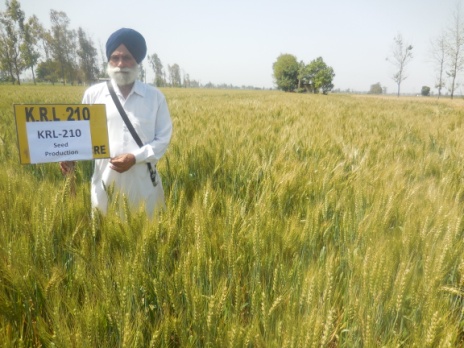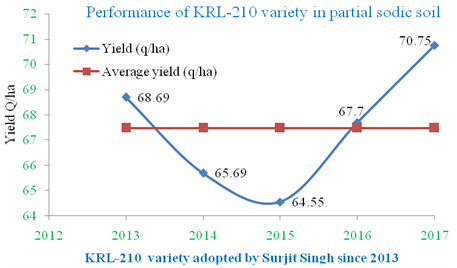 Shri Surjeet Singh, a farmer known for his grassroots innovations, and producing quality seed lives in village Baras, Karnal. He came into contact with ICAR-Central Soil Salinity Research Institute, Karnal during 2013 to get advisory on soil sodicity, and produce quality seed of KRL-210 in farmer’s participatory mode and enhancing his livelihood by developing his own seed network (farmer to farmer market). He has been sowing the CSSRI bred salt tolerant wheat variety KRL-210 since 2013 with remarkable yield (64.55 to 70.75 q/ha) on soils characterized as slightly alkali (pH range of 8.45±0.15). He use to sow the seed of KRL-210 in salt affected soils between first to second week of November with zero or reduced tillage using seed-cum-fertilizer drill. In order to harvest bold grains of KRL-210 (for seed purpose) with enhanced number of tillers, he calibrated his seed-drill to sow KRL-210 variety with lower seed rate of 55 kg/ha at 18 cm row spacing as against the recommended seed rate of 100 kg/ha with 22 cm row spacing. Shri Singh reduced the nitrogen fertilizer by 10% (135-140 kg N/ha), but maintained 15% higher P (58-60 kg P2O5/ha) application. Although he has been applying 1-2 irrigation normally since past 15 years in any of the wheat variety, for example during 2016-17 he irrigated KRL-210 only once after 30 days of seed sowing after experiencing weather pattern. No subsequent irrigations were applied as moisture requirement was fulfilled with intermittent rainfall received with 6 rainy days (total 96.3 mm rainfall) during January and March 2017, and optimum moisture remained in the field till harvest of the crop. The crop was harvested on 4 April, 2017 and yield data was recorded. With variability of 3.63%, the average yield of KRL-210, in past five years (2013-2017), was observed to be 67.47q/ha and maximum yield of 70.75 q/ha during 2016-17. This could be possible owing to creative farmer’s management practices, relatively more number of effective tillers in KRL-210 (452-476/m2) and higher grain weight [(46.2-48.1 g/1000-grains) (during 2016-17)]. Performance of Surjit Singh’s adaptations with KRL-210 resulted in almost 25-30.0 % saving of resources with better monitory returns (B:C) with MSP of wheat along with conserving natural resources and enhancing environmental sustainability. Other than routine sell on MSP, he has been selling KRL-210 as seed on an average 70-90 quintals every year with price Rs 3000/q, and could earn Rs 195, 000/ha from KRL-210 seed through farmers’ network.
Shri Surjeet Singh, a farmer known for his grassroots innovations, and producing quality seed lives in village Baras, Karnal. He came into contact with ICAR-Central Soil Salinity Research Institute, Karnal during 2013 to get advisory on soil sodicity, and produce quality seed of KRL-210 in farmer’s participatory mode and enhancing his livelihood by developing his own seed network (farmer to farmer market). He has been sowing the CSSRI bred salt tolerant wheat variety KRL-210 since 2013 with remarkable yield (64.55 to 70.75 q/ha) on soils characterized as slightly alkali (pH range of 8.45±0.15). He use to sow the seed of KRL-210 in salt affected soils between first to second week of November with zero or reduced tillage using seed-cum-fertilizer drill. In order to harvest bold grains of KRL-210 (for seed purpose) with enhanced number of tillers, he calibrated his seed-drill to sow KRL-210 variety with lower seed rate of 55 kg/ha at 18 cm row spacing as against the recommended seed rate of 100 kg/ha with 22 cm row spacing. Shri Singh reduced the nitrogen fertilizer by 10% (135-140 kg N/ha), but maintained 15% higher P (58-60 kg P2O5/ha) application. Although he has been applying 1-2 irrigation normally since past 15 years in any of the wheat variety, for example during 2016-17 he irrigated KRL-210 only once after 30 days of seed sowing after experiencing weather pattern. No subsequent irrigations were applied as moisture requirement was fulfilled with intermittent rainfall received with 6 rainy days (total 96.3 mm rainfall) during January and March 2017, and optimum moisture remained in the field till harvest of the crop. The crop was harvested on 4 April, 2017 and yield data was recorded. With variability of 3.63%, the average yield of KRL-210, in past five years (2013-2017), was observed to be 67.47q/ha and maximum yield of 70.75 q/ha during 2016-17. This could be possible owing to creative farmer’s management practices, relatively more number of effective tillers in KRL-210 (452-476/m2) and higher grain weight [(46.2-48.1 g/1000-grains) (during 2016-17)]. Performance of Surjit Singh’s adaptations with KRL-210 resulted in almost 25-30.0 % saving of resources with better monitory returns (B:C) with MSP of wheat along with conserving natural resources and enhancing environmental sustainability. Other than routine sell on MSP, he has been selling KRL-210 as seed on an average 70-90 quintals every year with price Rs 3000/q, and could earn Rs 195, 000/ha from KRL-210 seed through farmers’ network.
Adaptation practices of ShriSurjit Singh compared with other farmers’ practices
| Adaptation components | Sh. Surjit Singh’s practice | Practices followed by other farmers |
| Variety | KRL 210 | HD 2967 |
| Seed rate (kg/ha) | 55 | 100 |
| Method of sowing | Zero till | Rotavator/Zero till |
| Spacing (cm) | 18 | 20-22 |
| Fertilizer application | ||
| Nitrogen (kg N/ha) | 135-140 | 165-195 |
| Phosphorus (kg P2O5/ha) | 58-60 kg | 50 |
| Irrigation (No.) | 1-2 | 3-4 |
| Yield (q/ha) | 70.75 | 60 |
| Cost of cultivation (Rs/ha)* | 12986 | 18855-19238 |
| Gross returns @ Rs 1625/q1 | 114970 | 97500 |
| Benefit : Cost ratio1 | 8.85 | 5.07-5.46 |
Other input costs being considered common while calculating cost of cultivation under both the practices.
1 This exclude the income generated from KRL-210 as seed sell for which this variety was adopted by Shri Surjit Singh

It is to highlight that other than using KRL-210 since 2013, Shri. Surjit Singh has been continuing his informal agronomic experimentations with less seed and water since last about one and half decades to cope-up with climate variability. Such informal agronomic experimentation led by him in association (2013-2017) with CSSRI for assessing sodicity, providing salt tolerant wheat KRL-210, and farmer networking support, provide an example of co-production of adaptive knowledge for adapting abiotic stresses and enhancing livelihood resilience.
(Source: ICAR-Central Soil Salinity Research Institute, Karnal )







फेसबुक पर लाइक करें
यूट्यूब पर सदस्यता लें
X पर फॉलो करना X
इंस्टाग्राम पर लाइक करें